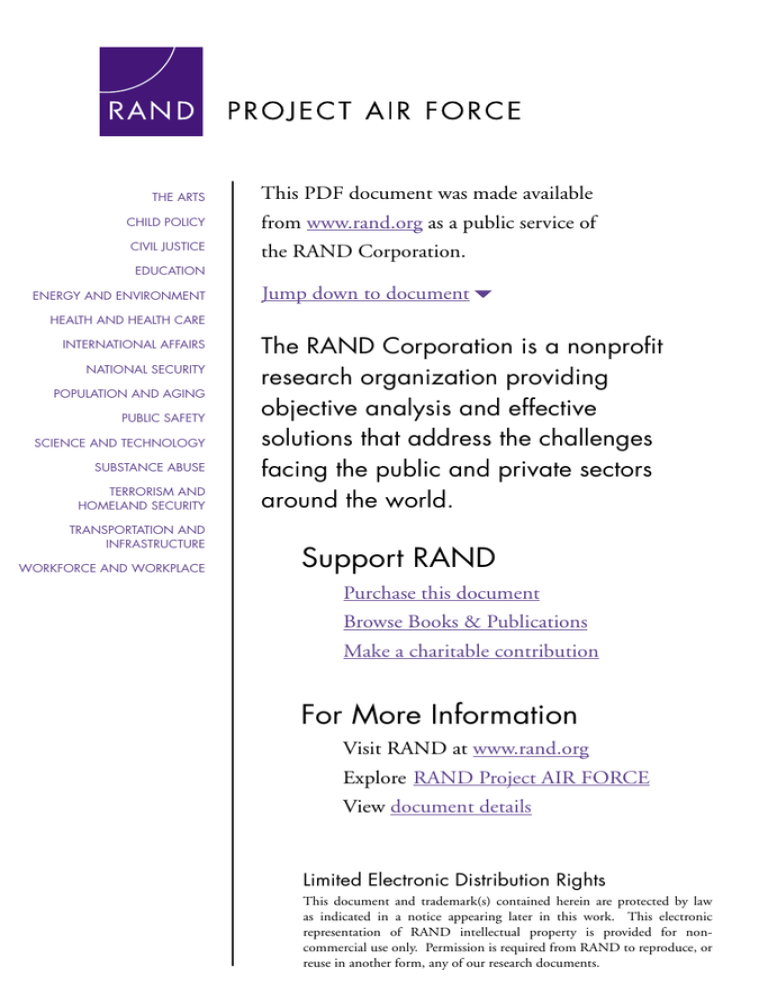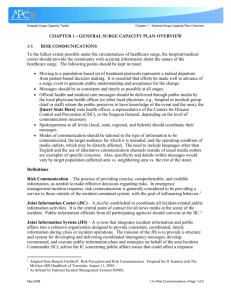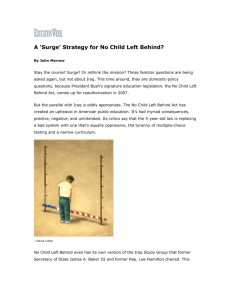
THE ARTS
This PDF document was made available
CHILD POLICY
from www.rand.org as a public service of
CIVIL JUSTICE
the RAND Corporation.
EDUCATION
ENERGY AND ENVIRONMENT
Jump down to document6
HEALTH AND HEALTH CARE
INTERNATIONAL AFFAIRS
NATIONAL SECURITY
POPULATION AND AGING
PUBLIC SAFETY
SCIENCE AND TECHNOLOGY
SUBSTANCE ABUSE
TERRORISM AND
HOMELAND SECURITY
TRANSPORTATION AND
INFRASTRUCTURE
WORKFORCE AND WORKPLACE
The RAND Corporation is a nonprofit
research organization providing
objective analysis and effective
solutions that address the challenges
facing the public and private sectors
around the world.
Support RAND
Purchase this document
Browse Books & Publications
Make a charitable contribution
For More Information
Visit RAND at www.rand.org
Explore RAND Project AIR FORCE
View document details
Limited Electronic Distribution Rights
This document and trademark(s) contained herein are protected by law
as indicated in a notice appearing later in this work. This electronic
representation of RAND intellectual property is provided for noncommercial use only. Permission is required from RAND to reproduce, or
reuse in another form, any of our research documents.
This product is part of the RAND Corporation monograph series.
RAND monographs present major research findings that address the
challenges facing the public and private sectors. All RAND monographs undergo rigorous peer review to ensure high standards for
research quality and objectivity.
Rethinking How the
Air Force Views
Sustainment Surge
Cynthia R. Cook, John A. Ausink, Charles Robert Roll, Jr.
Prepared for the United States Air Force
Approved for public release; distribution unlimited
The research described in this report was sponsored by the United States
Air Force under Contract F49642-01-C-0003. Further information may
be obtained from the Strategic Planning Division, Directorate of Plans,
Hq USAF.
Library of Congress Cataloging-in-Publication Data
Cook, Cynthia R., 1965–
Rethinking how the Air Force views sustainment surge / Cynthia R. Cook,
John A. Ausink, Charles Robert Roll, Jr.
p. cm.
“MG-372.”
Includes bibliographical references.
ISBN 0-8330-3831-1 (pbk. : alk. paper)
1. United States. Air Force—Supplies and stores. 2. United States. Air Force—
Operational readiness. 3. Airplanes, Military—United States—Maintenance and
repair. 4. United States. Air Force—Procurement. I. Ausink, John A. II. Roll,
Charles Robert. III. Title.
UG1103.C66 2005
358.4'14—dc22
2005022520
The RAND Corporation is a nonprofit research organization providing
objective analysis and effective solutions that address the challenges
facing the public and private sectors around the world. R AND’s
publications do not necessarily reflect the opinions of its research clients
and sponsors.
R® is a registered trademark.
Cover image: U.S. Air Force photo by Sue Sapp
© Copyright 2005 RAND Corporation
All rights reserved. No part of this book may be reproduced in any
form by any electronic or mechanical means (including photocopying,
recording, or information storage and retrieval) without permission in
writing from RAND.
Published 2005 by the RAND Corporation
1776 Main Street, P.O. Box 2138, Santa Monica, CA 90407-2138
1200 South Hayes Street, Arlington, VA 22202-5050
201 North Craig Street, Suite 202, Pittsburgh, PA 15213-1516
RAND URL: http://www.rand.org/
To order RAND documents or to obtain additional information, contact
Distribution Services: Telephone: (310) 451-7002;
Fax: (310) 451-6915; Email: order@rand.org
Summary
Each of the military services, including the Air Force, faces the challenge of keeping its weapon systems in good repair so that they are
ready to be used in battle during wartime and for training in times of
peace. Sustainment,1 or repair and maintenance, is an ongoing
requirement to be planned for and managed. There are variations in
the level of support required to fix weapon systems, generally based
on how heavily the systems are used. “Sustainment surge” describes
the increase in the requirement to repair weapon systems and components during the increased operational demands of wartime or
contingency operations.2 “Core” capabilities are loosely understood
to be skills that should be retained by government employees in
government-owned facilities so that they are prepared to respond to
surge requirements. Planning for surge is an ongoing activity that the
Air Force and the other services need to have in place. (See pages
1–2.)
The threat environment faced by the United States, which
drives sustainment surge planning, changes over time. At the end of
the Cold War, military planning was based on the idea that the
United States should be able to fight two simultaneous major theater
wars. In 2002, the Department of Defense (DoD) decided that a new
____________
1 Describing the broad scope of the Air Force’s sustainment processes is beyond the scope of
this report. The RAND reports referred to in the Preface provide insight into the topic.
2
A surge may also be caused by an unexpected technical flaw that requires every unit of a
weapon system be repaired.
ix
x
Rethinking How the Air Force Views Sustainment Surge
force-planning construct should instead provide for (1) deterrence in
four critical theaters, backed by the ability to (2) swiftly defeat two
aggressors in the same time frame, while (3) preserving the option for
one massive offensive to occupy an aggressor’s capital and replace the
regime and (4) having the ability to execute several lesser contingencies. A more recent shift in discussions of the security environment
highlights four security challenges: “traditional” challenges from
states employing legacy and advanced military capabilities and recognizable military forces in known forms of conflict, thus challenging
our power; “irregular” challenges from unconventional methods
adopted by non-state actors to counter stronger state opponents, they
eroding our power; “disruptive” challenges from international competitors that develop breakthrough technological capabilities to supplant U.S. advantages, thus marginalizing our power; and “catastrophic” challenges from terrorists and rogue states that use weapons
of mass destruction (WMD) or WMD-like effects, thus paralyzing
our power. 3 (See pages 3–4.)
In this research, we examine whether changes in the security
environment and in the nature of conflicts for which the Air Force
prepares are adequately reflected in the planning and execution of
sustainment surge operations. We look at three major issues:
• How has the demand for sustainment surge changed? Are the
concepts of core and surge outdated?
• Has legislation hindered Air Force management in developing
effective and efficient ways to manage surge?
• How can the effectiveness and efficiency of surge planning be
improved in the future? Are changes needed in planning, contract management, or data collection?
This report addresses all three questions, using quantitative sustainment data from depots and information obtained from interviews
with depot personnel.
____________
3
See Arthur Cebrowski, Director, Office of Force Transformation, “Transforming Transformation,” Transformation Trends, April 19, 2004.
Summary
xi
What have we found? The available data on depot production
and overtime since 1991 indicate that the nature of surge has indeed
changed. Instead of the large increases expected in the Cold War
model (which would lead to double and triple overtime situations),
data covering operations from Desert Storm to Enduring Freedom
and Iraqi Freedom show relatively modest changes in production and
overtime. Some of those we interviewed argued that depots must still
plan for a large-scale surge that would require greater increases in
production than are observed in the data; however, the satisfactory
depot responses to recent major contingencies, combined with a large
and largely untapped commercial production capacity, indicate to us
that sizing depots for a Cold War–type surge is not necessary—
especially if contractors are better integrated into surge planning. The
Cold War–era concept of surge does not reflect the current challenges
that the Air Force must face, and it does not incorporate the new
reality, in which surge represents “business as usual.” The depots are
managing to deal with variation in requirements without large
increases in employment or even in overtime. (See pages 27–28.)
A review of the legislative history (and of DoD responses)
related to military depot operations reveals that while there has been
much concern about retaining certain “core” functions in government facilities, there has also been an ongoing discussion about just
what those core functions might be. In addition, while the retention
of core functions in government is meant to ensure an adequate
response to the production demands of surge operations, there is
apparently no congressional requirement that all work related to surge
operations be performed by government personnel. This fact is
important, because many managers in Air Force depots assume that
the requirement exists. Over time, legislative restrictions on the
amount of depot work that can be contracted out has added to some
of the confusion about what constitutes “core” and who is allowed to
accomplish the increased workloads in surge situations. Legislation
may not have directly hindered depot management in developing
effective and efficient ways to manage surge, but misunderstandings
about the language may limit their willingness to explore all the legal
options for surge planning. Furthermore, the concept of “core” is suf-
xii
Rethinking How the Air Force Views Sustainment Surge
ficiently fuzzy that the term itself could be discarded. This would not
mean that the congressionally imposed limit on outsourced sustainment need change or even that the various justifications that have
been offered in its defense are not important, but rather that the
maintenance of some level of internal capacity be simply viewed as a
“just-in-case” defense resource. (See page 23.)
Any lack of clarity in the legislation has not meant that Headquarters has doubts about incorporating contractors in surge planning. In fact, we found strong support for this approach. However,
our interviews at the depots found that there was real concern about
the downsides of formally incorporating surge clauses into contracts.
Depot personnel indicated that adding these types of clauses generally
increased total contract costs and that it was usually possible to accelerate work without formal agreement. While the acceleration would
come at a price, the price was paid only if the work was actually
needed. In addition to concerns about costs, there was a lack of confidence in contractor responsiveness in the event of surge, even if
surge provisions exist in the contract. These concerns and other issues
aired during our interviews suggest that contractors are not seen as
true partners in the surge process, nor are they seen as good candidates for such a partnership. However, little or no data in support of
these views were provided. Contractors can be used during surge and
should be incorporated into future planning. (See pages 47–49.)
Air Force depot structure and management practices changed
significantly in the early to mid-1990s. Depot consolidation included
the closing of significant depot facilities—at Kelly Air Force Base in
San Antonio, Texas, and McClellan Air Force Base in Sacramento,
California—leaving the three depots that exist today. Management
changes, such as two-level maintenance and lean logistics, were
implemented at roughly the same time. New data systems were put in
place, and the Air Force made further efforts to improve depot operations. However, individual depots introduced some approaches
(including data systems) independently, and information across
depots is not usually directly comparable. A formal, top-level
approach to data systems and overall knowledge management could
contribute to more standardization among depots. (See pages 53–54.)
Summary
xiii
Also in the 1990s, optimization algorithms were developed to
improve the prioritization of spare parts allocation. The computer
model and management system called EXPRESS (Execution and Prioritization of Repair Support System) was fully implemented by 1995
and is used today to set priorities for depot repair of spare parts.
While this system has been useful in managing some surge requirements, there are critical assets for which EXPRESS is not applicable,
and ensuring the availability of these assets requires other approaches
to surge planning. (See pages 6–7.)
Surge has become part of regular ongoing depot activity instead
of an unusual event. Furthermore, recent contingencies in which
there have been increases in flying hours have not led to overwhelming increases in depot repair. Depot work is not necessarily linked to
actual demand at a fixed point in time; appropriate planning can help
the depots proactively prepare for expected conflicts. For example, the
Logistics Support Analysis conducted during the lead-up to Operation Iraqi Freedom showed that when the surge order was issued, the
depots had already taken steps in anticipation of the order. The Air
Force should incorporate a variety of initiatives as it develops an
approach that recognizes that surge is part of normal operations—
both in execution and in planning. These include continual metric
development and assessment, benchmarking internal operations with
those of contractors, improving (and in some cases centralizing) data
systems, and incorporating contractors into the surge planning process.
We recommend that the Air Force develop better knowledge
management that could be used in support of surge planning and
operations. Air Force leadership should be able to use it to gain insight into how production is organized and managed, including
information on capacities and abilities of both facilities and human
capital, and into how contractors are linked into this process. They
should consider what metrics would be most useful and should design
the data systems to accurately and quickly collect the data that would
support those metrics. This will require a centralized discussion
engaging all three depots, Headquarters Air Force Materiel Command, and the office of the Assistant Secretary of the Air Force for
xiv
Rethinking How the Air Force Views Sustainment Surge
Installations, Environment and Logistics (SAF/IE). (See pages 68–
69.)
Finally, we recommend that the Air Force develop centralized
guidance on how to manage contractors as a potential surge asset. We
have found no reason why contractors cannot be used in this way and
furthermore have found local examples where they have been efficiently used for surge. But there is no clear policy on how to incorporate contractors, and the depots each take a different approach, from
trying to avoid their use to seeing them as a source of flexibility for
surge. The push for clear policy needs to come from Headquarters, at
a level above the depots themselves. (See page 69.)
Any centralization must take into account the different cultures
at the depots. They may be slower or faster to adopt changes and may
require more or less training. Incorporating the perspectives of the
three depots during the process of planning for change improves the
likelihood that the end result will be a usable plan.





